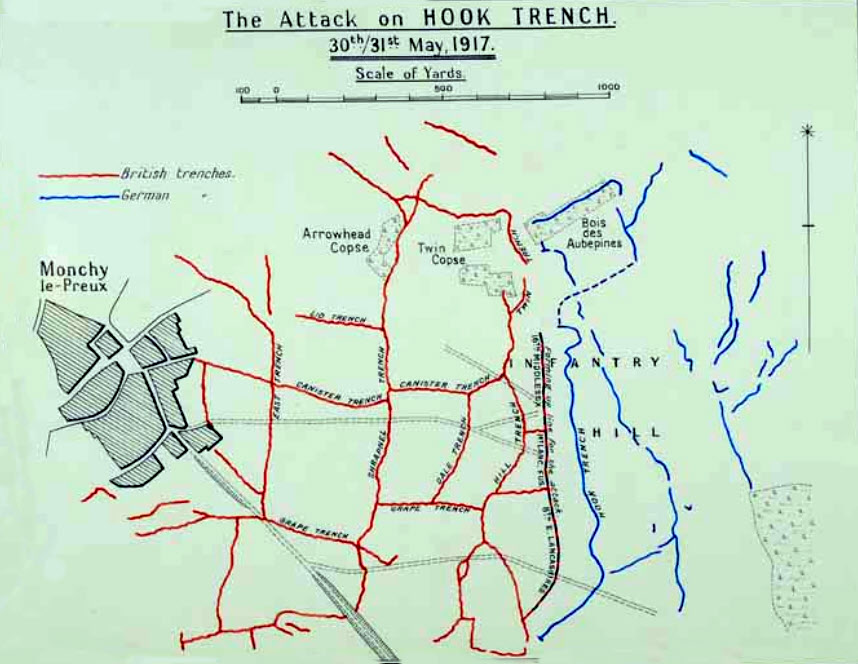
201397. Royal Field Artillery, “A” Battery, 62nd Brigade
William Gadie was born in early 1897, the only son of William Thomas Gadie (born Settle, Yorks) and Julia (nee Asquith) born Streetside, Ossett. The couple had married in 1888 in Ossett. By 1911, William Gadie (64) is a retired elementary school teacher, but his wife Julia (52) is still working as an elementary school teacher and the couple are living at 12, Westfield Terrace, Gawthorpe, Ossett. In the 1880s, William T. Gadie was a schoolmaster at Holy Trinity School on Church Street, Ossett and may have moved there soon after it opened in 1875. In 1901, there was also an Annie Ethel Gadie (19) living with the couple and described as their daughter.
William Cecil Gadie enlisted on the 23rd of August 1915 and died of wounds, aged 20 years on the 11th June 1917. He was awarded the 1915 Star, British and Victory medals posthumously. The 62nd Brigade was part of the 12th (Eastern) Division from formation in August 1914 during the rest of WW1. In 1917, they were in action at Arras in The First Battle of the Scarpe, The Battle of Arleux and The Third Battle of the Scarpe. They remained in the Arras sector until the 30th of October when they moved to Hesdin for the Cambrai offensive in which the Division suffered heavy losses.
The “Ossett Observer” 1 carried this report of his death: “The war has cut short the career of another Ossett young man in the person of Gunner William Cecil Gadie (20) of the Royal Field Artillery, the only son of Mr. and Mrs. W.T. Gadie of Westfield Terrace, Gawthorpe, Ossett, both of whom are well-known and have had a long connection with the teaching profession locally.
Enlisting in the summer of 1915, Gunner Gadie was attached to the Army Service Corps, and within a week of donning military uniform went to Rouen, where he was engaged upon clerical work at the base. At the time he enlisted, he was employed in the treasurer’s department at the County Hall, Wakefield and had previously attended the Wakefield Grammar School. In October, last year, an opportunity was given to non-combatants to join fighting units, and, along with about a score of his comrades, Gunner Gadie volunteered and was accepted in the artillery. Eventually, he returned to England and was stationed on the south coast for artillery training. In March 1917 he proceeded to France and, within a few days of landing, went up the line and joined a battery of guns.
That he has been engaged in a quarter which has been under the heavy bombardment of the enemy has been known to his parents. Towards the end of April, the manner in which the young soldier conducted himself under trying circumstances gained for him high praise from his officer, who recommended him, along with two comrades, for the award of the Military Medal.
It seems that early one morning, while an ammunition column, of which Gunner Gadie formed part, was taking ammunition to a battery they were heavily shelled by the Germans. Unloading their wagons, the men proceeded with their ammunition on horseback. Eight enemy shells burst among the column, and the man immediately in front of Gunner Gadie was among several killed. After halting in the vain hope of the shelling subsiding, Gunner Gadie and the other adopted another route by which they managed to reach one battery safely. While they were unloading, however, the firing of the enemy was so insistent that more men of the column were killed and the horses stampeded, but Gunner Gadie returned with his pair of horses to the ammunition base.
During the last week Mr. and Mrs. Gadie received a field postcard, sent by an officer, stating that their son had been wounded and admitted to hospital, and it was followed on Monday by an official telegram, bearing the sad news that he had died on the 11th inst.
A memorial service is to be held at Gawthorpe and Chickenley Heath Parish Church on Sunday evening, July 1st.”
Between the 17th of May and 19th of October 1917, the Division held positions east of Monchy le Preux, mounting several raids and small scale attacks and beating off some made against them, notably in the area of Hook Trench, Pick Avenue and Tites Copse. Much manual work took place, for the position held in May was of shell holes and disconnected parts of trenches, with few dugouts and no communications.2

Above: Monchy le Preux area, the location of 12th (Eastern) Division and probably close to where William Cecil Gadie was wounded or was killed in June 1917.
Cecil William Gadie is buried in Duisans British Cemetery 3, Etrun, Pas de Calais, France at grave reference IV. J. 20. The area around Duisans was occupied by Commonwealth forces from March 1916, but it was not until February 1917 that the site of this cemetery was selected for the 8th Casualty Clearing Station. The first burials took place in March and from the beginning of April the cemetery grew very quickly, with burials being made from the 8th Casualty Clearing Station (until April 1918), the 19th (until March 1918), and the 41st (until July 1917). Most of the graves relate to the Battles of Arras in 1917, and the trench warfare that followed. From May to August 1918, the cemetery was used by divisions and smaller fighting units for burials from the front line. In the Autumn of 1918 the 23rd, 1st Canadian and 4th Canadian Clearing Stations remained at Duisans for two months, and the 7th was there from November 1918 to November 1920. There are now 3,205 Commonwealth servicemen of the First World War buried or commemorated at Duisans British Cemetery. There are also 88 German war graves.
References:
1. “Ossett Observer”, 24th June 1917